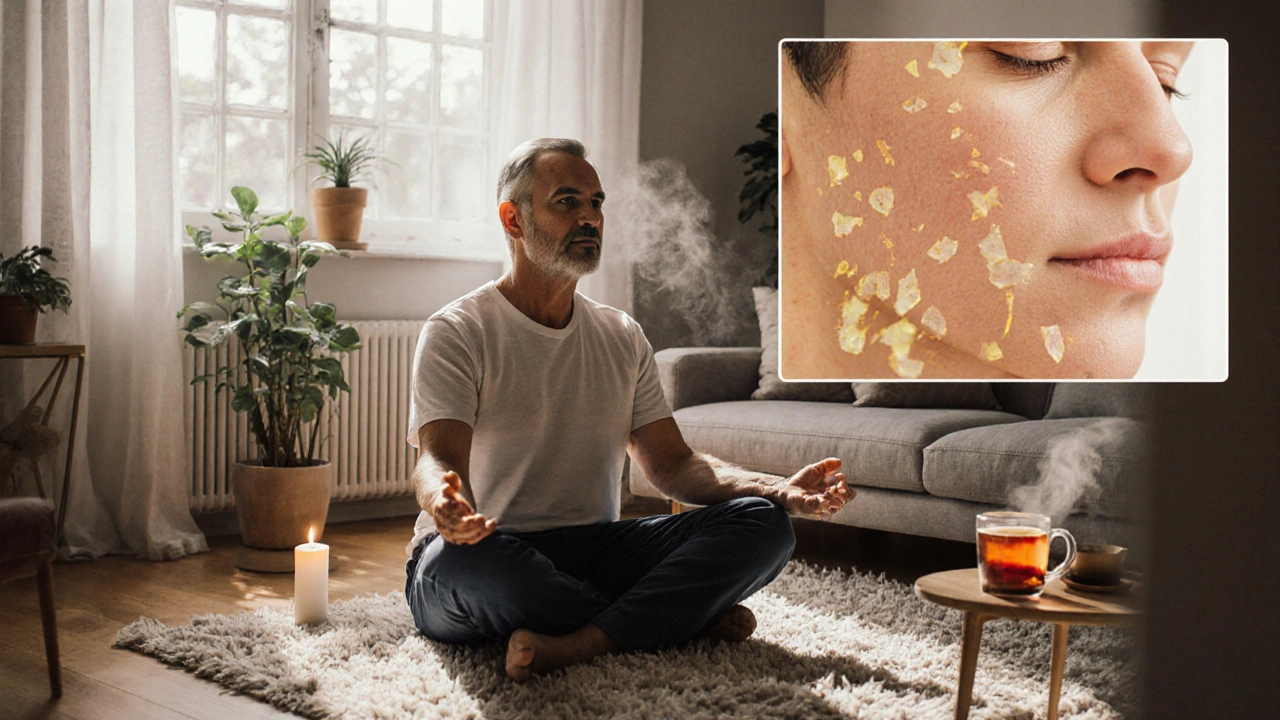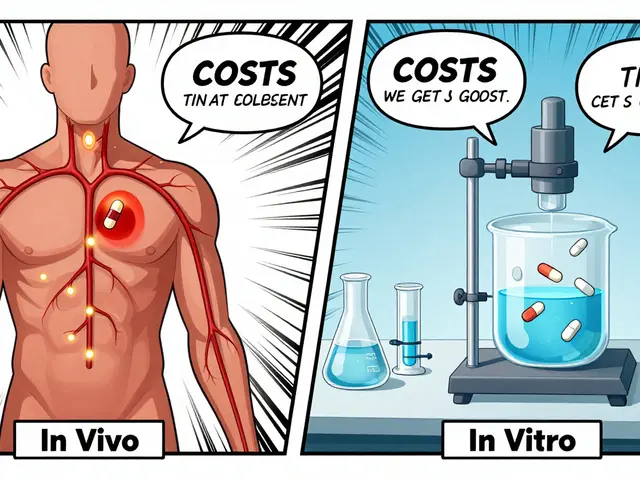
Quick Take
- Stress releases hormones that can irritate skin cells and trigger rashes.
- Common stress‑related rashes include eczema, psoriasis, and hives.
- Managing stress, supporting the skin barrier, and using targeted skin care can break the cycle.
- Seek professional help if a rash spreads quickly, hurts, or shows signs of infection.
- Simple habits like sleep hygiene, mindful breathing, and gentle moisturising often make the biggest difference.
Why Stress and Your Skin Talk to Each Other
When you feel overwhelmed, stress a physiological response that releases hormones like cortisol can flare up your skin. The connection isn’t just “in your head.” Stress kicks off a cascade of chemicals that directly affect skin cells, blood vessels, and the immune system.
Think of your skin as a nervous system on the outside. It has its own network of nerves, immune cells, and hormones that respond to what’s happening inside you. When stress hits, the body releases cortisol a glucocorticoid hormone that helps regulate metabolism and immune function. In the short term, cortisol can calm inflammation, but chronic elevations weaken the skin barrier and make it more porous, letting irritants slide in.
At the same time, stress can spike histamine an immune‑system messenger that causes itching, redness, and swelling. Histamine release is why you might feel an itchy welt after a stressful meeting or a late‑night deadline. The itch‑scratch loop then damages the skin further, setting the stage for a full‑blown rash.
Hormonal Cascade: From Brain to Skin
The brain‑skin axis works like this:
- Stress perception - Your amygdala signals danger.
- Adrenal response - The adrenal glands dump cortisol and adrenaline.
- Immune modulation - Cortisol tries to keep inflammation in check, but chronic exposure reduces the production of natural moisturizing factors.
- Barrier breakdown - Lipid layers thin, making skin more susceptible to irritants.
- Histamine surge - Mast cells release histamine, causing itching and redness.
- Rash manifestation - The combination of barrier loss and histamine leads to visible skin eruptions.
This loop explains why a single stressful day can leave you with a patch of red, flaky skin the next morning.
Rash Types Most Likely to Show Up During Stress
Not every rash is stress‑related, but three conditions have a strong link to emotional tension:
- Eczema (atopic dermatitis) a chronic, itchy inflammation that flares with stress, allergens, and dry skin
- Psoriasis an autoimmune scaling disorder that can worsen when cortisol spikes and sleep quality drops
- Hives (urticaria) raised, red welts caused by rapid histamine release, often triggered by acute anxiety
Each looks a little different, but they share the same underlying driver: a compromised skin barrier and an overactive immune response.
Spotting the Warning Signs
Knowing when stress is the culprit helps you act fast. Look for these patterns:
- Rash appears after a stressful event (work deadline, argument, travel).
- Itchiness intensifies at night when cortisol levels remain high.
- Flare‑ups improve after a weekend of rest, mindfulness, or a good night’s sleep.
- Rash often starts in flexural areas (inner elbows, behind knees) for eczema, or on the scalp and elbows for psoriasis.
If you notice rapid spreading, pus, fever, or severe pain, it’s time to see a doctor-these could signal infection or a different condition.

Managing Stress to Calm Your Skin
Stress management isn’t a luxury; it’s part of your skin‑care regimen. Here are evidence‑backed habits that actually lower cortisol and histamine levels:
- Mindful breathing - Five minutes of diaphragmatic breathing can cut cortisol by up to 30% within a few days.
- Regular movement - Moderate aerobic exercise (30min, 3‑4times/week) releases endorphins and improves sleep quality.
- Consistent sleep schedule - Aim for 7‑9hours; poor sleep spikes cortisol and aggravates inflammation.
- Limit caffeine & alcohol - Both can heighten the stress response and dehydrate the skin barrier.
- Digital detox - Reducing screen time before bed lowers sympathetic nervous system activity, easing nighttime itching.
Pair these habits with a skin‑friendly routine, and you’ll often see the rash fade before you finish a single bottle of cream.
Skin‑Care Steps That Support a Stress‑Resilient Barrier
Even the best stress‑reduction plan needs a solid topical backbone. Follow this simple three‑step approach twice daily:
- Gentle cleanse - Use a fragrance‑free, sulfate‑free cleanser. Harsh surfactants strip lipids, making cortisol‑induced barrier loss worse.
- Targeted moisturiser - Apply a moisturiser containing ceramides, hyaluronic acid, and niacinamide to restore lipid layers and reduce transepidermal water loss. Lock it in while skin is still damp.
- Anti‑itch aid (if needed) - Over‑the‑counter antihistamine such as cetirizine or diphenhydramine can calm histamine‑driven itching for 12‑24hours. Use sparingly and under medical advice if you have chronic conditions.
For flare‑ups that don’t respond to home care, a short course of a topical corticosteroid prescribed by a dermatologist can break the cycle, but keep usage under 2weeks to avoid further barrier damage.
Quick Comparison of Stress‑Related Rashes
| Feature | Eczema | Psoriasis | Hives |
|---|---|---|---|
| Typical pattern | Red, dry, scaly patches; often in flexural areas | Silvery‑white plaques with well‑defined borders | Raised, red welts that appear suddenly and fade within 24hrs |
| Itch level | Moderate‑to‑severe, constant | Mild‑moderate, often worse with stress | Intense, stinging |
| Stress trigger | Highly sensitive | Noticeable flare after cortisol spikes | Acute anxiety can cause rapid outbreaks |
| First‑line treatment | Moisturiser + low‑potency steroid | Vitamin D analogues, phototherapy | Antihistamine, cold compress |
When to Call a Dermatologist
If any of the following occurs, schedule an appointment:
- Rash spreads over more than 10% of body surface in a day.
- Signs of infection: pus, crusting, fever, or swollen lymph nodes.
- Persistent itching that disrupts sleep despite antihistamines.
- Uncertain diagnosis - a professional can rule out allergy, autoimmune disease, or infection.
A dermatologist may run a skin‑biopsy, prescribe stronger topicals, or suggest systemic therapies that address both stress and inflammation.
Frequently Asked Questions
Can stress really cause a rash, or is it just a coincidence?
Yes. Scientific studies show that chronic stress raises cortisol and histamine, both of which weaken the skin barrier and trigger inflammation. The link is strongest for eczema, psoriasis, and hives.
How quickly can stress‑related rashes appear after a stressful event?
Rashes can show up within a few hours to a couple of days. Acute anxiety often leads to hives almost instantly, while eczema or psoriasis may take longer to flare.
Is it safe to use over‑the‑counter antihistamines for stress‑induced itching?
For most adults, short‑term use of non‑sedating antihistamines like cetirizine is safe and effective. Always check with a pharmacist if you’re pregnant, nursing, or taking other medications.
What lifestyle changes help lower cortisol levels?
Regular aerobic exercise, 7‑9hours of sleep, mindfulness meditation, reduced caffeine, and limiting screen time before bed are the most evidence‑backed ways to keep cortisol in check.
Can a good moisturiser really prevent stress‑related flare‑ups?
A barrier‑repair moisturiser with ceramides, hyaluronic acid, and niacinamide reduces transepidermal water loss by up to 40%. Keeping the barrier strong makes it harder for stress‑generated hormones to provoke inflammation.
5 Comments
Jim Butler
September 29, 2025 at 06:26 AM
Thank you for sharing your perspective on stress and skin health. While I respect diverse viewpoints, the scientific literature does support a link between chronic cortisol elevation and barrier dysfunction. Implementing the recommended lifestyle adjustments can indeed benefit many individuals. Stay motivated and keep exploring evidence‑based strategies! 😊👍
Renee van Baar
September 29, 2025 at 23:06 PM
Stress can indeed act as a silent trigger for many skin conditions, and understanding the pathway is the first step toward relief. When cortisol remains elevated, the skin barrier loses essential lipids, making it more permeable to irritants. This permeability allows allergens and microbes to penetrate more easily, which in turn provokes an immune response. Histamine release compounds the problem by creating that maddening itch‑scratch cycle that damages the epidermis further. One practical way to break this loop is to prioritize barrier repair with moisturizers that contain ceramides, hyaluronic acid, and niacinamide. Apply the product while your skin is still damp to lock in moisture and support lipid synthesis. In addition to topical care, incorporating stress‑reduction techniques such as diaphragmatic breathing can lower cortisol levels within days. Even a brief five‑minute breathing exercise, performed twice daily, has been shown to reduce physiological stress markers. Regular moderate aerobic activity, like a brisk walk or cycling, not only improves circulation but also promotes the release of endorphins that counteract stress hormones. Aim for at least 150 minutes of such activity each week, and you may notice your skin responding more calmly to daily challenges. Sleep hygiene should not be overlooked; maintaining a consistent bedtime schedule supports the body’s natural cortisol rhythm. Limit caffeine and alcohol in the evening, as both can disrupt sleep quality and dehydrate the skin. Reducing screen time before bed helps lower sympathetic nervous system activity, which can diminish nighttime itching. If a flare persists despite these measures, a short course of a low‑potency topical steroid prescribed by a dermatologist can provide relief, but it should be used sparingly. Finally, keep a simple diary of your stressors and skin reactions; patterns often emerge that guide personalized adjustments. By integrating these habits, you empower your skin to become more resilient against the invisible pressures of modern life.
Mithun Paul
September 30, 2025 at 11:36 AM
While the previous comment is replete with well‑intentioned recommendations, it fails to acknowledge the underlying methodological flaws in many cited studies. The correlation between cortisol and barrier function is often confounded by external variables such as diet, genetics, and environmental pollutants. Moreover, the blanket suggestion to employ ceramide‑rich moisturizers overlooks the heterogeneity of dermatitis phenotypes, where certain lipid‑based formulations may exacerbate rather than ameliorate symptoms. A rigorous, individualized assessment is paramount before prescribing generic interventions.
Sandy Martin
October 1, 2025 at 02:53 AM
I completely understand how overwhelming it can feel when stress seems to manifest on your skin. The key is to start small-maybe add a short breathing exercise before bed and a gentle cleanser that doesn't strip your skin. Over time you'll notice that even minor adjustments can make a big difference. Keep tracking what works for you, and be patient with the process.






Hanna Sundqvist
September 28, 2025 at 18:57 PM
i think the whole stress thing is just a hoax they made up to sell more creams.